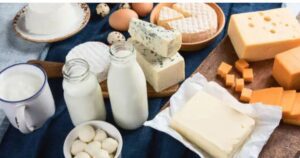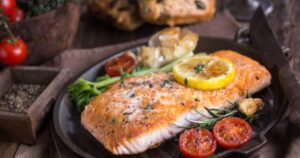Protein for Older Adults: Best Sources for Healthy Aging:

Maintaining strength, energy, and independence after 70 is a challenge for many older adults.
One nutrient plays a key role in this process: protein.
Many seniors in America do not meet their daily protein needs, leading to muscle loss, fatigue, and slower recovery.
This guide covers the best sources of protein for older adults and practical strategies to stay strong, healthy, and energetic.
Why Protein Matters for Older Adults
After the age of 60, the body starts to lose muscle mass — a condition called sarcopenia.
Protein is essential to slow down this process. It helps in:
- Repairing and maintaining muscle tissue
- Improving metabolism and bone strength
- Supporting immune health and energy balance
According to National Institutes of Health (NIH), older adults should aim for at least 1.0–1.2 grams of protein per kilogram of body weight daily to preserve muscle and vitality.
Top Protein Sources for Older Adults:
1. Eggs and Dairy Products
Eggs and dairy are some of the easiest and most affordable protein sources for older adults. A single egg provides around 6–7 grams of high-quality protein, while dairy products like milk, yogurt, and cheese offer both protein and calcium — two essential nutrients for maintaining bone strength and muscle mass as we age.
For seniors, these foods are especially beneficial because they also contain vitamin D and B12, which help support energy levels and nerve function. Choosing low-fat milk or Greek yogurt can provide extra protein without adding unnecessary fat.
How to include: Enjoy boiled or scrambled eggs for breakfast, add yogurt to fruit bowls, or use milk in smoothies for a quick, nutrient-rich snack.
2. Lean Meat and Poultry
Lean meats such as chicken breast, turkey, and lean cuts of beef or pork are excellent sources of complete protein. They contain all the essential amino acids required for muscle repair, tissue health, and immune function. For older adults, lean meats help prevent muscle loss, also known as sarcopenia, which commonly occurs with aging.
Choosing lean cuts helps reduce saturated fat intake while providing important nutrients like iron and zinc, which support oxygen transport and metabolism.
How to include: Grill or bake chicken or turkey instead of frying. Add lean ground meat to soups or stews for an easy and balanced meal.
3. Fish and Seafood
Fish and seafood offer not only protein but also healthy omega-3 fatty acids that promote heart and brain health. Fatty fish such as salmon, mackerel, and sardines are particularly beneficial for older adults because omega-3s can reduce inflammation, improve cognitive function, and support joint flexibility.
Regular fish intake is also linked to a lower risk of cardiovascular diseases — a major concern among aging populations in the USA.
How to include: Try eating fish at least twice a week. Grill or bake instead of deep-frying to retain nutrients and avoid extra calories.
4. Beans, Lentils, and Legumes
Plant-based proteins like beans, lentils, and chickpeas are nutrient-dense and fiber-rich, making them a perfect choice for older adults. They not only provide protein but also contain complex carbohydrates, iron, potassium, and folate — all essential for maintaining steady energy and digestive health.
These foods are ideal for seniors who want to manage their cholesterol levels and support heart health, as they are naturally low in fat and high in fiber.
How to include: Add cooked lentils to soups or salads, prepare bean-based stews, or enjoy hummus as a protein-packed snack.
5. Nuts, Seeds, and Soy Products
Nuts, seeds, and soy-based products like tofu or soy milk are versatile sources of plant protein. They also supply healthy fats, magnesium, and antioxidants that support heart and brain health in older adults. A small handful of almonds or walnuts can provide both protein and healthy omega-3 fatty acids.
Soy products, in particular, are a great option for those who prefer vegetarian or lactose-free diets. Tofu and edamame are easy to cook and rich in isoflavones, which may help improve bone health.
How to include: Sprinkle chia or flaxseeds on oatmeal, snack on a handful of nuts, or add tofu cubes to stir-fried vegetables for a complete meal.
Final Tip: Older adults should aim for a balanced mix of both animal and plant-based proteins to maintain muscle strength, support healthy aging, and enhance overall vitality.
How to Include Protein in Every Meal
- Breakfast: eggs, Greek yogurt, or protein smoothie
- Lunch: lean meat, lentils, or beans in salads or soups
- Snacks: nuts, seeds, or cottage cheese
- Dinner: fish, tofu, or beans with vegetables
Pro Tips: Actionable Steps for Older Adults
- Track daily protein intake using a journal or app to ensure 1–1.2g per kg body weight
- Combine resistance training 2–3 times per week with protein-rich meals
- Use lighter weights or resistance bands to prevent injury while building strength
- Include protein at every meal, not just dinner
- Focus on gradual consistency instead of extreme workouts or diets
- Pair physical activity with hydration, balanced nutrition, and adequate sleep
- Consult a healthcare professional before starting new supplements or intensive routines
How Protein Supports Immune Health in Older Adults
As we age, our immune system becomes weaker. Adequate protein intake for older adults helps produce antibodies and immune cells that protect against infections.
Including foods like eggs, fish, yogurt, and legumes can boost immunity naturally while supporting muscle strength and overall wellness.
Mental Health Benefits of Strength Training After 70
Strength training isn’t just for muscles — it also improves brain health.
Regular resistance exercises release endorphins, reduce anxiety and depression, and improve cognitive function. Seniors who combine protein-rich nutrition with exercise often report better focus, memory, and mood.
Bone Health and Longevity Through Protein and Exercise
Muscles and bones work together to maintain mobility.
Consuming sufficient protein along with resistance training strengthens bones, reduces risk of osteoporosis, and prevents falls.
Adding calcium and vitamin D-rich foods like dairy, fortified plant-based milk, or fish with bones further enhances bone density and longevity.
Simple Daily Routine to Maximize Strength and Nutrition
Here’s a practical daily plan for older adults:
- Morning: Breakfast with eggs, Greek yogurt, or protein smoothie; light stretching or short walk.
- Midday: Balanced lunch with lean meat, beans, or lentils; optional 10–15 min light resistance training.
- Evening: Snack on nuts or cottage cheese; gentle strength exercises like chair squats or resistance bands.
- Night: Ensure adequate sleep (7–8 hours) to support muscle recovery, hormone balance, and mental wellness.
Following this routine consistently helps improve muscle health after 70, maintain energy, and support healthy aging.
Hydration and Recovery Tips for Older Adults
Water is often overlooked but is critical for muscle function and recovery.
Older adults may feel less thirsty, so aim for small frequent sips throughout the day.
Pair hydration with protein intake and rest after strength sessions to maximize muscle repair and overall vitality.
Extra Health Topics Related to Protein and Strength
Immune Support Through Protein
Protein helps produce antibodies and immune cells. Consuming adequate protein daily strengthens immunity, reducing infection risk and supporting recovery after illness.
Mental Health Benefits of Strength Training
Resistance exercises improve brain function, release endorphins, and reduce stress. Combining protein intake with strength training can improve memory, focus, and mood.
Bone Health and Longevity
Protein combined with calcium and vitamin D strengthens bones, reduces osteoporosis risk, and supports overall mobility and independence.
Hydration and Recovery
Water is essential for muscle function and nutrient absorption. Seniors should sip water throughout the day and pair hydration with protein-rich meals and proper rest.
Daily Routine for Maximum Results
Morning: Protein-rich breakfast + light stretching
Midday: Balanced lunch + optional resistance exercises
Evening: Healthy snacks + gentle strength exercises
Night: 7–8 hours of quality sleep for muscle recovery and energy restoration
Frequently Asked Questions (FAQs)
1. How much protein do older adults need daily?
About 1.0–1.2 grams per kilogram of body weight. For a 70 kg person, that’s roughly 70–85 grams daily.
2. Is strength training safe after 70?
Yes, if done with proper form, supervision, and gradual progression. Resistance bands or light weights are ideal for beginners.
3. Can plant-based foods provide enough protein?
Absolutely. Beans, lentils, tofu, tempeh, nuts, and seeds can meet protein needs if consumed in adequate portions.
4. Does protein help with mental health in seniors?
Yes, combined with exercise, protein supports neurotransmitter production, mood regulation, and cognitive function.
Conclusion
Adequate protein for older adults, combined with strength training, hydration, and proper sleep, is the foundation of healthy aging.
Following practical daily routines and pro tips ensures seniors maintain muscle, mobility, energy, and independence.
Small consistent steps accumulate into significant long-term health benefits.
Disclaimer
This article is for educational purposes only and is not medical advice. Always consult a healthcare professional before changing your diet, supplement use, or exercise routines.
This content follows Google’s quality and indexing guidelines for health information.

